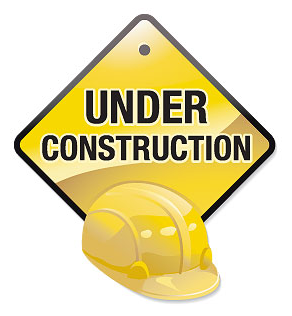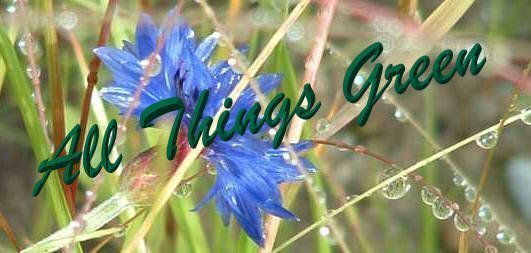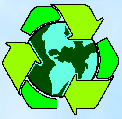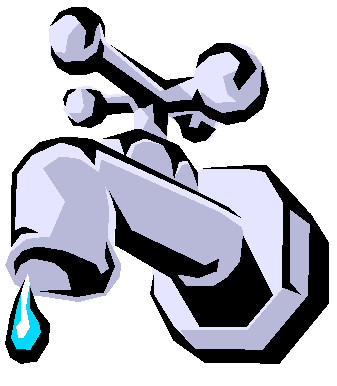|
|
|
In Your Backyard
Put nature to work in your
yard
In nature, soil recycles dead plants into
nutrients for new plant growth. Plants are adapted to the water, sun
and soil available in their site. Maintaining a wide variety of
healthy plants, soil organisms, beneficial insects and animals can
keep most pests and diseases in check.
By working with nature, you can have a
great-looking yard that's easier to care for, cheaper to maintain
and healthier for families, pets, wildlife and the environment.
How? Start with these five steps:
-
Build and maintain healthy soil
-
Plant right for your site
-
Practice smart watering
-
Adopt a holistic approach to pest management
-
Practice natural lawn care
From
http://www.epa.gov/epaoswer/non-hw/green/owners.htm#soil
Reduce
Waste
- Select low maintenance/slow growing plants
and grasses.
- Reduce or eliminate plastic silt fencing and
substitute with blankets, berms, and filtersocks made of compost
for erosion control.
- Switch from pressure-treated wood to plastic
lumber for decks, benches, and signs.
- Return wooden pallets and other shipping
materials to your supplier whenever possible.
- When replacing an existing hardscape or
structure, deconstruct, reuse and recycle all possible materials
such as metal, wood, shingles, concrete, and pavement.
- Minimize site and soil disruptions to the
maximum extent possible.
- Cluster structures to maximize open space.
- Minimize turf grass and paved areas - keep as
much natural area as possible.
Water
- Conserve water through xeriscaping.
- Incorporate compost into the soil to help
improve water absorption and retention.
- Top-dress your turf with compost.
- Reduce non-permeable hardscape wherever
possible.
- Place mulch over a plant's root zone to
reduce moisture evaporation and conserve water.
- Install drip irrigation systems.
- Install composting toilets in remote
locations to reduce water and servicing requirements.
- Clean equipment with compressed air whenever
possible. Grass clippings and debris should be collected and
composted.
Air/Energy
- Strategically plant vegetation outside and
around buildings to reduce indoor heating and cooling needs.
- Use hand or electric equipment where ever
feasible to reduce emissions.
- Use biobased fuels and lubricants in place of
petroleum.
- Implement scheduled equipment maintenance
program for increased efficiency & reduced emissions.
Fertilizers and Pesticides
- Use compost as a soil amendment to help
reduce the need for chemical fertilizers or pesticides.
- Incorporate native plants in your landscape—
they generally require less fertilizers and pesticides.
- Implement an Integrated Pest Management (IPM)
program.
- Spot treat whenever possible.
- Set mower blades higher to fight weeds and
diseases without pesticides.
- Grasscycle—leave grass clippings in place
(don't bag) when mowing.
- Produce less green waste by limiting
fertilizer and water use.
- Use mulch around trees and in flowering beds
as weed prevention.
- Purchase only what you need and can use for a
specific treatment.
- Return unused excess product to supplier if
possible.
- If you cannot return excess product, contact
your local solid waste agency and your state pesticide disposal
program to determine if a waste or pesticide program now
commonly called "Clean Sweep" is available. These efforts by
state and local governments typically focus on agricultural
pesticides, but may also include other pesticides used by
homeowners, golf courses, and highway departments.
Climate Change
- Plant trees to shade paved areas and help
reduce the summer "heat-island" effect.
- Compost organic waste in lieu of burning or
burying.
From
http://www.epa.gov/epaoswer/non-hw/green/reduce.htm
Reuse
Waste
- Take apart nonreturnable wood pallets to
reuse the wood (e.g., edging around plant beds) or chip it for
use on site for mulch.
- Chip woody waste and tree clippings into
mulch for use on-site.
- Donate healthy plants to local nonprofit
organizations when reconfiguring or removing trees and shrubs
from your landscape.
- Reuse or increase the use and efficiency of
existing sites before cutting into new sites.
- Reuse soils within the work site; create
mounds or berms to serve as wind breaks or to add visual
interest.
Water
- Use gray water, reclaimed water, or collected
rainwater for irrigation and equipment wash downs.
From
http://www.epa.gov/epaoswer/non-hw/green/reuse.htm
Recycle
Waste
- Recycle bedding trays and plant containers
from annuals and other greenery
- Triple rinse and recycle plastic commercial
containers.
- Recycle used oil and tires from your vehicles
and equipment.
- Provide recycling receptacles next to trash
receptacles.
- Send green waste and food waste that cannot
be composted on site to a local composting facility.
- Reclaim land - turn waste land into usable
property and a valuable asset.
From
http://www.epa.gov/epaoswer/non-hw/green/recycle.htm
Rebuy
From simple to extensive, consider some of these rebuy opportunities
when available. This is just a short list of possible options to
help improve your environmental profile and bottom line—the
opportunities are virtually limitless.
Waste
- Select plastic lumber made from recycled
bottles and bags for benches and other outdoor structures.
- Incorporate rubberized asphalt (made from
recycled tires) for parking lots, walking, running, bike, or
cart paths.
- Purchase patio blocks and lawn edging
containing recovered plastic or postconsumer rubber.
- Amend soils and turf with high quality
compost.
- Use recycled glass for golf course bunker
sand, beach sand, or filter media.
- Specify high performance concrete, which can
contain fly ash and/or other recycled materials to double the
life of conventional pavement, wall, and bridge applications.
Visit the
Coal Combustion Products Partnership site for more
information.
- Restructure waste disposal contracts to pay
only for waste actually disposed - weight-based versus fixed
rate; if a weight-based rate is not possible and your dumpster
is only half-full each time -- switch to less frequent pickups.
- Install composting toilets in remote
locations such as parks and golf courses to save on waste
disposal costs.
Water
- Buy hoses, tubing, trickle irrigation systems
made from recovered plastic and old tires.
- Use biobased cleaners and solvents for
equipment.
- Install a green vegetated roof to reduce or
eliminate storm water and "heat island" effect. See EPA's
Storm water Management page for more information.
- Purchase and incorporate plants that require
minimal or no supplemental watering.
Air & Energy
- Purchase biodiesel and biobased lubricants
for your equipment.
- Compost makes an excellent air filter media
for volatile organic compounds (VOCs).
- Specify
Green Buildings
requirements for building structures.
- Plant trees to replace those removed or
damaged during construction.
- Buy locally produced goods and services
whenever possible to reduce transportation emissions and costs.
- Purchase or rent fuel efficient vehicles for
your fleet.
- Use high efficiency lighting for roadways,
parking lots, security, and landscaping.
- Use solar powered lighting and signage
wherever possible.
- Utilize solar, wind, and other renewable
energy sources. Purchase "green power" from renewable energy
sources if available.
Fertilizers and Pesticides
- Purchase organic, biobased, or slow-release
fertilizers.
- Use
biopesticides instead of conventional pesticides.
From
http://www.epa.gov/epaoswer/non-hw/green/rebuy.htm
Composting
Yard trimmings and food residuals together constitute
24 percent of the U.S. municipal solid waste stream. That's a lot of
waste to send to landfills when it could become useful and
environmentally beneficial compost instead!
Composting offers the obvious benefits of resource
efficiency and creating a useful product from organic waste that
would otherwise have been landfilled.
Composting is Easy!
A compost pile can be set up in a corner of the yard with few
supplies. Choose a level spot about 3- to 5-feet square near a
water source and preferably out of direct sunlight. Clear the
area of sod and grass. When building a composting bin, such as
with chicken wire, scrap wood, or cinder blocks, be sure to
leave enough space for air to reach the pile. One removable side
makes it easier to tend the pile.
Many foods can be composted, including
vegetable trimmings, egg shells, coffee grounds with filters,
and tea bags. In addition to leaves, grass, and yard clippings,
vacuum cleaner lint, wool and cotton rags, sawdust, shredded
newspaper, and fireplace ashes can be composted. DO NOT compost
meats, dairy foods, or any fats, oil, or grease because they can
attract pests.
Start the pile with a 4-inch layer of leaves,
loose soil, or other coarse yard trimmings. If you are going to
compost food scraps (a slightly more involved process), you
should mix them with yard trimmings when adding them to the
pile. Alfalfa meal or clean cat litter may be added to the pile
to absorb odors. In dry weather, sprinkle water on the pile, but
don't get it too soggy. Turn the pile every few weeks with a
pitchfork to circulate air and distribute moisture evenly. Don't
be surprised by the heat of the pile or if you see worms, both
of which are part of the decomposition process. Make sure
children do not play in the composting pile or bin.
In most climates, the compost is done in 3 to
6 months when it becomes a dark crumbly material that is uniform
in texture. Spread it in the garden or yard beds or under the
shrubbery. The compost also can be used as potting soil.
From
http://www.epa.gov/epaoswer/non-hw/reduce/catbook/compost.htm
Background
Compost is organic material that can be used
as a soil amendment or as a medium to grow plants. Mature
compost is a stable material with a content called humus that is
dark brown or black and has a soil-like, earthy smell. It is
created by: combining organic wastes (e.g., yard trimmings, food
wastes, manures) in proper ratios into piles, rows, or vessels;
adding bulking agents (e.g., wood chips) as necessary to
accelerate the breakdown of organic materials; and allowing the
finished material to fully stabilize and mature through a curing
process.
Natural composting, or biological
decomposition, began with the first plants on earth and has been
going on ever since. As vegetation falls to the ground, it
slowly decays, providing minerals and nutrients needed for
plants, animals, and microorganisms. Mature compost, however,
includes the production of high temperatures to destroy
pathogens and weed seeds that natural decomposition does not
destroy.
Did You Know That Compost Can...
- Suppress plant diseases and pests.
- Reduce or eliminate the need for chemical
fertilizers.
- Promote higher yields of agricultural
crops.
- Facilitate reforestation, wetlands
restoration, and habitat revitalization efforts by amending
contaminated, compacted, and marginal soils.
- Cost-effectively remediate soils
contaminated by hazardous waste.
- Remove solids, oil, grease, and heavy
metals from stormwater runoff.
- Capture and destroy 99.6 percent of
industrial volatile organic chemicals (VOCs) in contaminated
air.
- Provide cost savings of at least 50
percent over conventional soil, water, and air pollution
remediation technologies, where applicable.
From
http://www.epa.gov/compost/
Organic Materials
Yard trimmings and food residuals together
constitute 23 percent of the U.S. waste stream, as documented by
EPA. An estimated 56.9 percent of yard trimmings were recovered
for composting or grass cycled in 2000, a dramatic increase from
the 12 percent recovery rate in 1990. Accompanying this surge in
yard waste recovery is a composting industry that has grown from
less than 1,000 facilities in 1988 to nearly 3,800 in 2000. Once
dominated by public sector operations, the composting industry
is increasingly entrepreneurial and private-sector driven, led
by firms that add value to compost products through processing
and marketing. Compost prices have been as high as $26 per ton
for landscape mulch to more than $100 per ton for high-grade
compost, which is bagged and sold at the retail level.
While yard trimmings recovery typically
involves leaf compost and mulch, yard trimmings can also be
combined with other organic waste, such as food residuals,
animal manure, and biosolids to produce a variety of products
with slightly different chemical and physical characteristics.
In contrast to yard trimmings recovery, only 2.6 percent of food
waste was composted in 2000. The cost-prohibitive nature of
residential food waste separation and collection is the primary
deterrent to expanding food waste recovery efforts. Yet in many
communities, edible food residuals are donated to the needy,
while inedible food residuals are blended into compost or
reprocessed into animal feed. In some areas, composting
operations are working with high-volume commercial and
institutional food producers to recover their food byproducts,
saving these firms significant disposal costs. For more
information on organic materials, visit the
Organic Materials Web site.
What to
Compost - The IN List
- Animal manure
- Cardboard rolls
- Clean paper
- Coffee grounds and filters
- Cotton rags
- Dryer and vacuum cleaner lint
- Eggshells
- Fireplace ashes
- Fruits and vegetables
- Grass clippings
- Hair and fur
- Hay and straw
- Houseplants
- Leaves
- Nut shells
- Sawdust
- Shredded newspaper
- Tea bags
- Wood chips
- Wool rags
- Yard trimmings
What Not
to Compost - The OUT List
Leave Out/Reason Why
- Black walnut tree leaves or twigs
- Releases substances that might be
harmful to plants
- Coal or charcoal ash
- Might contain substances harmful
to plants
- Dairy products (e.g., butter, egg
yolks, milk, sour cream, yogurt)
- Create odor problems and attract
pests such as rodents and flies
- Diseased or insect-ridden plants
- Diseases or insects might survive
and be transferred back to other plants
- Fats, grease, lard, or oils
- Create odor problems and attract
pests such as rodents and flies
- Meat or fish bones and scraps
- Create odor problems and attract
pests such as rodents and flies
- Pet wastes (e.g., dog or cat feces,
soiled cat litter)
- Might contain parasites,
bacteria, germs, pathogens, and viruses harmful to
humans
- Yard trimmings treated with chemical
pesticides
- Might kill beneficial composting
organisms
From
http://www.epa.gov/compost/
Water
Challenge: The
typical single-family suburban household uses at least 30 percent of
their water outdoors for irrigation. Some experts estimate that more
than 50 percent of landscape water use goes to waste due to evaporation
or runoff caused by overwatering!
Solution: Drip irrigation systems use between 20 to 50
percent less water than conventional in-ground sprinkler systems. They
are also much more efficient than conventional sprinklers because no
water is lost to wind, runoff, and evaporation. If your in-ground system
uses 100,000 gallons annually, you could potentially save more than
200,000 gallons over the lifetime of a drip irrigation system if
installed-that's a savings of at least $1,150!
From
http://www.epa.gov/watersense/index.htm
Landscape Irrigation
All too often, landscape irrigation wastes water—up to
1.5 billion gallons every day across the country. If homeowners
with irrigation systems hire WaterSense irrigation partners to perform
regular maintenance, they could reduce water used for irrigation by 15
percent, or about 9,000 gallons annually-that's the amount of water that
would flow from a garden hose nonstop for nearly a whole day.
From
http://www.epa.gov/watersense/index.htm
The EPA has more information on
GreenScaping
Water Wisely
Wise use of water for garden and lawn waterings not
only helps protect the environment, but saves money and provides for
optimum growing conditions. Simple ways of reducing the amount of water
used for irrigation include growing xeriphytic species (plants that are
adapted to dry conditions), mulching, adding water retaining organic
matter to the soil, and installing windbreaks and fences to slow winds
and reduce evapotranspiration.
Watering in the early morning before the sun is
intense helps reduce the water lost from evaporation. Installing rain
gutters and collecting water from downspouts also helps reduce water
use.
From
U. S. Department of Agriculture
Plant Needs for Water
Water is a critical component of photosynthesis, the
process by which plants manufacture their own food from carbon dioxide
and water in the presence of light. Water is one of the many factors
that can limit plant growth. Other important factors include nutrients,
temperature, and amount and duration light.
Plants take in carbon dioxide through their
stomata--microscopic openings on the undersides of leaves. Water is also
lost through the stomata in the process called transpiration.
Transpiration, along with evaporation from the soil surface, accounts
for the moisture lost from the soil.
When there is a lack of water in the plant tissue, the
stomata close to try to limit water loss. Wilting occurs when the
tissues lose too much water. Plants adapted to dry conditions have
developed numerous mechanisms for reducing water loss, including narrow
leaves, hairy leaves, and thick fleshy stems and leaves. Pines,
hemlocks, and junipers are also well adapted to survive extended periods
of dry conditions which they encounter each winter when the frozen soil
prevents the uptake of water. Cacti, with leaves reduced to spines and
having thick stems, are the best example of plants well adapted to
extremely dry environments.
From
U. S. Department of Agriculture
Choosing Plants for Low Water Use
You are not limited to cacti, succulents, or narrow
leafed evergreens when selecting plants adapted to low moisture
requirements. Many plants growing in humid environments are well adapted
to low levels of soil moisture. Numerous plants found growing in coastal
or mountainous regions have developed mechanisms for dealing with
extremely sandy, excessively well-drained soils, or rocky cold soils in
which moisture is limited for months at a time.
Plants Adapted to Sunny, Dry
Conditions
- Yucca gloriosa
- Broom (Cytisus spp.)
- Yarrow (Achillea spp.)
- Nasturtium (Tropaeolum majus)
- California poppy (Eschscholzia californica)
- Blanket flower (Gailardia spp.)
- Sedum spp.
- Gold dust (Alyssum saxatile)
- Moss rose (Portulaca grandiflora)
- Juniper (Juniperus spp.)
- Artemisia spp.
- Lavender (Lavendula spp.)
- Sage (Salvia spp.)
- Iris spp.
- Thyme spp.
- Crocus spp.
- Evening primrose (Oenothera biennis)
Indigenous plants -- plants that occur naturally in
the local environment -- will likely need less supplemental moisture
most years than non-native species. These species have evolved under the
local conditions and usually have well-developed mechanisms for
surviving extremes in the weather.
From
U. S. Department of Agriculture
Efficient Watering Methods
Trickle irrigation and drip irrigation systems help
reduce water use and meet the needs of plants. With these methods, very
small amounts of water are supplied to the base of the plants. Since the
water is applied directly to the soil, rather than onto the plant,
evaporation from leaf surfaces is reduced. The water is also placed
where it will do the most good, rather than sprayed over the entire
garden.
From
U. S. Department of Agriculture
Installing Irrigation Systems
An irrigation system can be easy to install. Numerous
products are readily available for home use. The simplest system
consists of a soaker hose that is laid out around the plants and
connected to an outdoor spigot. No installation is required and the hose
can be moved as needed to water the entire garden. A slightly more
sophisticated system is a slotted pipe system.
Slotted pipe system installation
- Sketch the layout you will need. If you intend to
water a vegetable garden, you may want one pipe next to every row or
one pipe between every two rows.
- Depending on your layout, purchase the required
lengths of pipe. You will need a length of solid pipe the width of
your garden. You will need lengths of perforated pipe the length of
your rows (the laterals) times the number of rows.
- Measure the distances between laterals and cut
the solid pipe to the proper lengths.
- Place t-connectors between the pieces of solid
pipe.
- Approximately in the center of the solid pipe,
place a t-connector to which a hose connector will be fitted.
- Cut perforated pipe to the length of the rows.
- Attach perforated pipe to the t-connectors.
Attach so that the perforations are facing downward. Cap the end of
the pipe.
- Connect garden hose to hose connector on solid
pipe. Adjust water from the spigot until water slowly emerges from
each of the laterals.
From
U. S. Department of Agriculture
Drip or Trickle Irrigation
The basic elements of a drip or trickle system consist
of the head, the tubing, and the emitters.
The head is the part of the system that connects to
your water supply. The major components of this may include a pressure
regulator, a filter, an anti-siphon valve, and an automatic timer. While
this may sound complicated and expensive, it is not. Installation of
these components will create a better operating system.
Consideration for the Head
- Many drip systems are designed to be used with
low water pressure, under 25 pounds per square inch (psi). Normal
city water pressure is about 55 psi. Therefore, a pressure regulator
should be installed.
- Because of the small size of the openings in the
emitters, they easily can become clogged by sediment in the water. A
filter should be installed to keep openers operating freely.
- Consider installing a back flow preventer. This
is a valve that prevents the accidental backflow of water in the
system getting into the water line. This may be required by city
ordinance in some municipalities. Considering the minor cost, it is
probably a wise investment for anyone considering a system.
- A timing device can be added to automatically
turn the system on and off. This can be as simple as a battery
operated attachment or a more permanent timer that is wired into
your electrical system.
Plastic tubing is used to get the water from the
source to the garden. This comes in many sizes. A variety of fittings
are available to go around corners and to connect pieces.
Plastic Tubing Considerations
- Check with the supplier for the maximum length of
tubing that can be run in any one direction. A general
recommendation is that 400 feet is the maximum for 1/2 inch tubing.
- Consider what you intend to water with the drip
system. You may need several different systems to best meet the
needs of various plants. Not all plants have the same water
requirements, and soil conditions in various parts of your yard may
vary. Trees, because of their large size and deep root systems,
probably will require less frequent but longer waterings. Well
mulched vegetable gardens high in organic matter or shady flower
gardens probably will require shorter watering times than gardens
with sandy soils or those in full sun.
Emitters deliver the small amounts of water to the
plants. Depending on the design, emitters can either be attached
directly to the pipe or attached to "spaghetti tube," a very small
flexible tube that can be placed next to plants or in pots. Emitters can
let water drip out very slowly, or small sprinkler emitters can be
installed to provide a spray pattern similar to a lawn sprinkler.
Sprinkler emitters may be appropriate for watering groundcover and
lawns.
The size of the emitter will influence the amount of
water delivered. Drippers vary in the amount of water delivered per
hour. Some deliver as little as one half gallon of water per hour while
others deliver up to 10 gallons per hour. Some emitters are adjustable
to deliver different rates of water. Sprinkler emitters also are
available in various flow rates as well as with different spray patterns
and coverage areas.
While these systems need more planning, they are
neither expensive or difficult to install. In most cases, no special
tools or skills are needed. Plastic pipe is punched with an inexpensive
tube punch that assures the proper hole size. Emitters or spaghetti
tubes snap into the hole. No gluing or soldering is required. Because
the holes are small, they can easily be plugged if you put one in the
wrong place. Some systems come with pre-assembled emitters at regular
intervals. Drip systems require periodic maintenance. You will also need
to check emitters to make sure they are working properly as they can
become clogged.
Once you have thought about your watering needs,
discuss your ideas with a supplier. Most trickle irrigation suppliers
will help you design a system to best meet your gardening needs.
From
U. S. Department of Agriculture
Harvest rain water for irrigation
For healthier flowers, shrubs and plants, save rain
water for your plants
|
|
|










